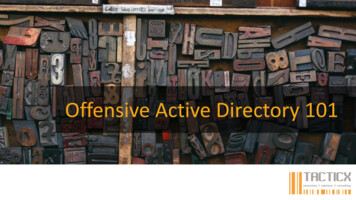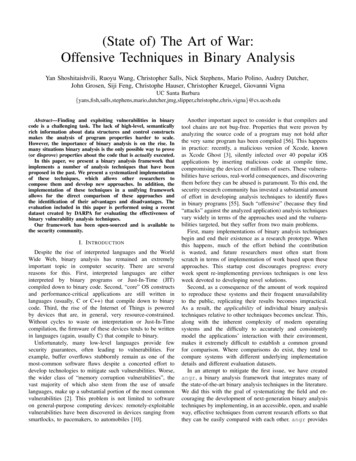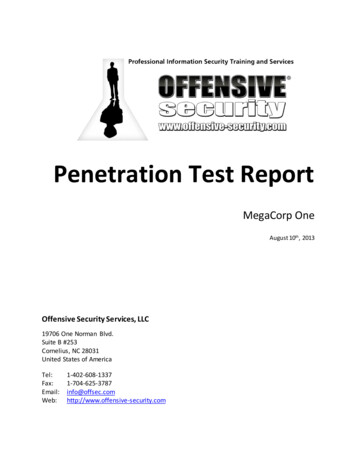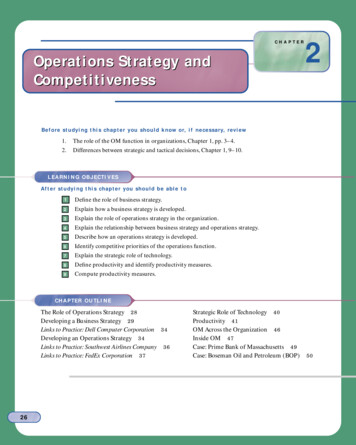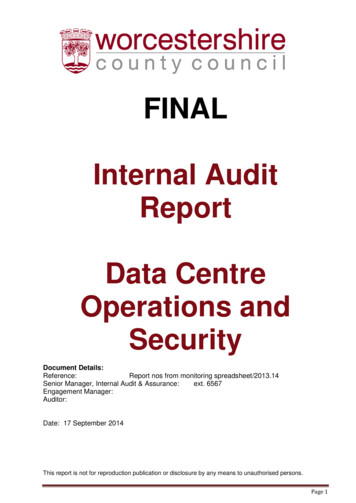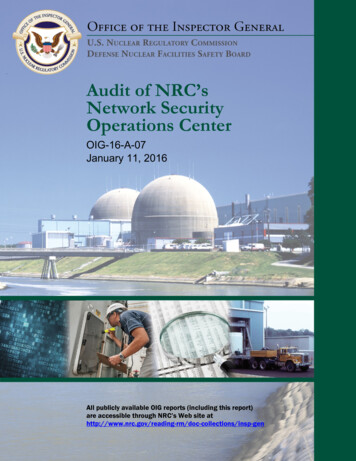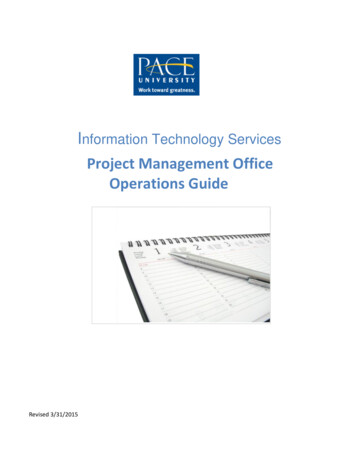
Transcription
*FM 20-3Field ManualNo. 20-3HeadquartersDepartment of the ArmyWashington, DC, 30 August 1999FM 20-3CAMOUFLAGE,CONCEALMENT, ANDDECOYSTABLE OF CONTENTSPREFACECHAPTER BASICSDoctrinal ther ConsiderationsCHAPTER THREATDoctrine2OrganizationData CollectionSensor SystemsCCD Versus Threat SensorsCHAPTER FUNDAMENTALSSection I — Principles3Avoiding DetectionIdentifying the ThreatAvoiding Detection by Routine SurveillanceDISTRIBUTION RESTRICTION: Approved for public release; distribution is unlimited.*This publication supersedes FM 20-3, 14 November 1990.
Taking CountermeasuresEmploying Realistic CCDMinimizing MovementUsing DecoysAvoiding Operational PatternsApplying Recognition FactorsSite SelectionCCD DisciplineSection II — Techniques and MaterialsTechniquesTests and EvaluationsNatural ConditionsData SourcesMaterialsCHAPTER OFFENSIVE OPERATIONSPreparations4BattleCHAPTER OFFENSIVE OPERATIONSPreparations5Survivability Positions and ObstaclesBattleCHAPTER HIGH-VALUE TARGETSSection I — CCD Planning6PlansObjectivePlanning ProcessSection II — Fixed InstallationsConceptCommand PostsSupply and Water PointsArmy Aviation SitesSection III — Relocatable UnitsMobility and CCDBuilt-In CapabilitiesCHAPTER SPECIAL ENVIRONMENTSDesert7Snow-Covered AreasUrban TerrainAPPENDIMETRIC CONVERSION CHART
X A.APPENDIX B.GUIDELINES FOR TACTICAL STANDING OPERATINGPROCEDURESContentCommanders' ResponsibilitiesFratricideAPPENDIX C.CAMOUFLAGE REQUIREMENTS AND PROCEDURESAPPENDIX D.INDIVIDUAL CAMOFLAGE, CONCEALMENT, ANDDECOYSLightweight Camouflage Screen SystemSupplemental CamouflageVehicle iderationsEmploymentAPPENDIX E.STANDARD CAMOUFLAUGE MATERIALSAPPENDIX F.THE GENEVA EMBLEM AND CAMOUFLAGE OFMEDICAL FACILITIESGLOSSARYBIBLIOGRAPHYAUTHORIZATION PAGE
PrefaceThis field manual (FM) is intended to help company-level leaders understand the principles andtechniques of camouflage, concealment, and decoys (CCD). To remain viable, all units mustapply CCD to personnel and equipment. Ignoring a threat's ability to detect friendly operationson the battlefield is shortsighted and dangerous. Friendly units enhance their survivabilitycapabilities if they are well versed in CCD principles and techniques.CCD is equal in importance to marksmanship, maneuver, and mission. It is an integral part of asoldier's duty. CCD encompasses individual and unit efforts such as movement, light, and noisediscipline; litter control; dispersal; and deception operations. Each soldier's actions mustcontribute to the unit's overall CCD posture to maximize effectiveness.Increased survivability is the goal of a CCD plan. A unit commander must encourage eachsoldier to think of survivability and CCD as synonymous terms. Training soldiers to recognizethis correlation instills a greater appreciation of CCD values.A metric conversion chart is provided in Appendix A.The proponent of this publication is HQ TRADOC. Send comments and recommendations onDepartment of the Army (DA) Form 2028 (Recommended Changes to Publications and BlankForms) directly to Commandant, United States Army Engineer School (USAES), ATTN: ATSEDOT-DD, Fort Leonard Wood, Missouri 65473-6650.This publication implements Standardization Agreement (STANAG) 2931, Orders for theCamouflage of the Red Cross and Red Crescent on Land in Tactical Operations.Unless this publication states otherwise, masculine nouns and pronouns do not refer exclusivelyto men.
Chapter 1BasicsCCD is the use of materials and techniques to hide, blend, disguise, decoy, or disrupt theappearance of military targets and/or their backgrounds. CCD helps prevent an enemyfrom detecting or identifying friendly troops, equipment, activities, or installations.Properly designed CCD techniques take advantage of the immediate environment andnatural and artificial materials. One of the imperatives of current military doctrine is toconserve friendly strength for decisive action. Such conservation is aided through soundoperations security (OPSEC) and protection from attack. Protection includes all actionsthat make soldiers, equipment, and units difficult to locate.DOCTRINAL CONSIDERATIONS1-1. CCD degrades the effectiveness of enemy reconnaissance, surveillance, and targetacquisition (RSTA) capabilities. Skilled observers and sophisticated sensors can bedefeated by obscuring telltale signs (signatures) of units on the battlefield. Preventingdetection impairs enemy efforts to assess friendly operational patterns, functions, andcapabilities.1-2. CCD enhances friendly survivability by reducing an enemy's ability to detect,identify, and engage friendly elements. Survivability encompasses all actions taken toconserve personnel, facilities, and supplies from the effects of enemy weapons andactions. Survivability techniques include using physical measures such as fighting andprotective positions; nuclear, biological, chemical (NBC) equipment; and armor. Theseactions include interrelated tactical countermeasures such as dispersion, movementtechniques, OPSEC, communications security (COMSEC), CCD, and smoke operations(a form of CCD). Improved survivability from CCD is not restricted to combatoperations. Benefits are also derived by denying an enemy the collection of informationabout friendly forces during peacetime.1-3. Deception helps mask the real intent of primary combat operations and aids inachieving surprise. Deception countermeasures can delay effective enemy reaction bydisguising information about friendly intentions, capabilities, objectives, and locations ofvulnerable units and facilities. Conversely, intentionally poor CCD can projectmisleading information about friendly operations. Successful tactical deception dependson stringent OPSEC.1-4. Smoke and obscurants are effective CCD tools and greatly enhance the effectivenessof other traditionally passive CCD techniques. Smoke and obscurants can changebattlefield dynamics by blocking or degrading the spectral bands used by an enemy'starget-acquisition and weapons systems. More recently developed obscurants are nowable to degrade nonvisual detection systems such as thermal infrared (IR) imaging
systems, selected radar systems, and laser systems. (See FM 3-50 for more informationon planning smoke operations.)RESPONSIBILITIES1-5. Each soldier is responsible for camouflaging and concealing himself and hisequipment. Practicing good CCD techniques lessens a soldier's probability of becoming atarget. Additionally, a thorough knowledge of CCD and its guiding principles allows asoldier to easily recognize CCD as employed by an enemy.1-6. A commander is responsible for CCD of his unit, and noncommissioned officers(NCOs) supervise well-disciplined soldiers in executing CCD. They use establishedstanding operating procedures (SOPs) and battle drills to guide their efforts. CCD is acombat multiplier that should be exploited to the fullest extent.1-7. An engineer is a battlefield expert on CCD. He integrates CCD into higher unitoperations and advises commanders on all aspects of CCD employment as it relates to aunit's current mission.PRIORITIES1-8. Every soldier and military unit has an inherent mission of self-protection, and theyshould use all CCD means available. However, CCD countermeasures have become morecomplicated due to advancing technology. Commanders must recognize that advancedtechnologies have— Enhanced the performance of enemy recon and surveillance equipment. Increased an enemy's ability to use electromagnetic (EM) signature analysis fordetecting friendly units. Reduced the time available to apply CCD because units must perform nearly allaspects of battlefield operations at an increased speed.1-9. When time, camouflage materials, or other resources are insufficient to provideadequate support to units, commanders must prioritize CCD operations. Considerationsfor establishing these priorities involve analyzing the mission, enemy, terrain, weather,troops, time available, and civilian considerations (METT-TC). The following sets forth aMETT-TC methodology to help determine CCD priorities: Mission. The mission is always the first and most important consideration. CCDefforts must enhance the mission but not be so elaborate that they hinder a unit'sability to accomplish the mission. Enemy. An enemy's RSTA capabilities often influence the camouflage materialsand CCD techniques needed to support a unit's mission. Before beginning a
mission, conduct an intelligence analysis to identify the enemy's RSTAcapabilities. Terrain and weather. The battlefield terrain generally dictates what CCDtechniques and materials are necessary. Different terrain types or backgroundenvironments (urban, mountain, forest, plains, desert, arctic) require specific CCDtechniques. (See Chapter 7 for more information.) Troops. Friendly troops must be well trained in CCD techniques that apply totheir mission, unit, and equipment. A change in the environment or the missionoften requires additional training on effective techniques. Leaders must alsoconsider the alertness of troops. Careless CCD efforts are ineffective and maydisclose a unit's location, degrade its survivability, and hamper its missionaccomplishment. Intelligence analysis should address the relative detectability offriendly equipment and the target signatures that unit elements normally project. Time. Time is often a critical consideration. Elaborate CCD may not be practicalin all tactical situations. The type and amount of CCD needed are impacted by thetime a unit occupies a given area, the time available to employ CCDcountermeasures, and the time necessary to remove and reemploy camouflageduring unit relocation. Units should continue to improve and perfect CCDmeasures as time allows. Civilian considerations. From conflict to war and from tactical to strategic,civilians in the area of operation (AO) may be active or passive collectors ofinformation. Commanders and their staffs should manage this collectioncapability to benefit the command and the mission.TRAINING1-10. CCD training must be included in every field exercise. Soldiers must be aware thatan enemy can detect, identify, and acquire targets by using resources outside the visualportion of the EM spectrum.INDIVIDUAL1-11. Each member of the unit must acquire and maintain critical CCD skills. Theseinclude the ability to analyze and use terrain effectively; to select an individual siteproperly; and to hide, blend, disguise, disrupt, and decoy key signatures using natural andartificial materials.CAUTIONEnsure that local environmental considerationsare addressed before cutting live vegetation orfoliage in training areas.
UNIT1-12. Unit CCD training refines individual and leader skills, introduces the element ofteam coordination, and contributes to tactical realism. If CCD is to conserve friendlystrength, it must be practiced with the highest degree of discipline. The deployment andteardown of camouflage; light, noise, and communications discipline; and signal securitymust be practiced and evaluated in an integrated mission-training environment. CCDproficiency is developed through practicing and incorporating lessons learned fromexercises and operations. A unit must incorporate CCD (who, what, where, when, andhow) into its tactical standing operating procedure (TACSOP). (Appendix B providesadditional guidance on integrating CCD into a unit's field TACSOP.) Generally, CCD isadditive and synergistic with other defensive measures. CCD enhances unit survivabilityand increases the likelihood of mission success. A unit that is well trained in CCDoperations more easily recognizes CCD as employed by an enemy, and this recognitionenhances a unit's lethality.EVALUATION1-13. CCD training should be realistic and integrated with a unit's training evaluations.Employ the following techniques to enhance training evaluations: Have small-unit leaders evaluate their unit's CCD efforts from an enemy'sviewpoint. How a position looks from a few meters away is probably of littleimportance. Evaluators should consider the following:n Could an approaching enemy detect and place aimed fire on the position?n From what distance can an enemy detect the position?n Which CCD principle was ignored that allowed detection?n Which CCD technique increased the possibility of detection? Use binoculars or night-vision or thermal devices, when possible, to show a unithow it would appear to an enemy. Use photographs and videotapes, if available, of a unit's deployments andpositions as a method of self-evaluation. Incorporate ground-surveillance-radar (GSR) teams in training when possible. Letthe troops know how GSR works and have them try to defeat it. Request aerial multispectral (visual, IR, radar) imagery of friendly unit positions.This imagery shows how positions appear to enemy aerial recon. Unit leadersshould try to obtain copies of opposing forces (OPFOR) cockpit heads-up display(HUD) or videotapes, which are excellent assessment tools for determining aunit's detectability from an enemy's perspective. Another valuable assessment toolis the overhead imagery of a unit's actions and positions. Overhead imagery isoften difficult to obtain; but if a unit is participating in a large-scale exercise or
deployment, the imagery probably exists and can be accessed through the unit'sintelligence channels. Use OPFOR to make training more realistic. Supporting aviation in an OPFORrole also helps. When possible, allow the OPFOR to participate in the after-actionreview (AAR) following each mission. The unit should determine what factorsenabled the OPFOR to locate, identify, and engage the unit and what the unitcould have done to reduce its detectability.OTHER CONSIDERATIONS1-14. Warfare often results in personnel losses from fratricide. Fratricide compelscommanders to consider CCD's effect on unit recognition by friendly troops.1-15. Army policy prescribes that camouflage aids b
Chapter 1 Basics CCD is the use of materials and techniques to hide, blend, disguise, decoy, or disrupt the appearance of military targets and/or their backgrounds.
